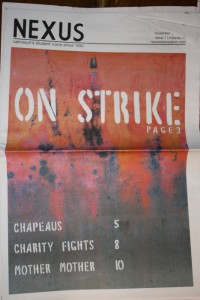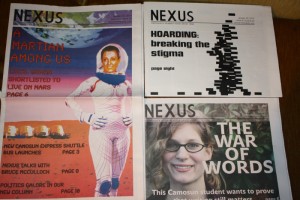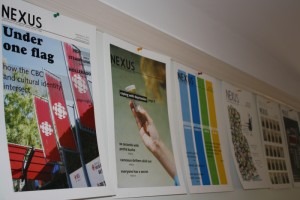Web exclusive: Check out some of the stories we’re talking about in this feature here.
THE BEGINNING
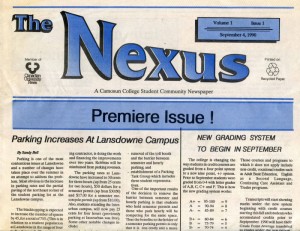 A student newspaper should reflect the thoughts and feelings of the student body; it should be written by students, for students. It should provide relevant information and connect each and every student through shared experiences, making a whole.
A student newspaper should reflect the thoughts and feelings of the student body; it should be written by students, for students. It should provide relevant information and connect each and every student through shared experiences, making a whole.
Since its conception as Camosun College’s student newspaper in 1990, I can confidently say that Nexus has done just that. It’s what the word “nexus” means, after all: a connected group, or the central and most important point or place. In many ways, Nexus strives to be, and is, the nexus of the college for Camosun students.
“A student newspaper always reflects the latest and newest thoughts of young people,” says Barbara Risto, who was managing editor of Nexus from 1990 to 2003. “It can be a way for students to stay connected and know what’s going on in the politics of their student body or the college administration. I think it’s always refreshing to hear what people are talking about, what’s important to them… the student newspaper gives expression to that.”
While the basic tenets of the paper remain the same as when it started, the behind-the-scenes action has certainly changed. How the paper is put together is totally different now (all digital) than it was then (barbaric and delirious paste-up sessions and something called waxing).
Jason Schreurs was at the paper from 1999 until September 2015; he started as assistant editor and worked his way up to managing editor. He remembers the old days of newspaper-making at Camosun.
“It was very energetic,” says Schreurs. “People were really passionate about print media, and putting out a newspaper was a big thing in 1999 for a lot of students.”
Schreurs remembers the waxing process (something those new to media will probably never know) well. He says it involved a small handheld machine that actually waxed the paper. Then the paper was put on slats and delivered, by hand, to the printers. (Today we click a mouse button and the printer has it on their server.)
“We were forced to do the old archaic method of waxing it by hand,” says Schreurs. “It was a neat process but it was definitely not time-efficient.”
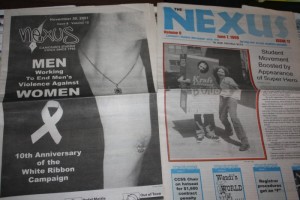 Schreurs says that covering issues that students find interesting has certainly seen the paper get some upset reactions over the years. He remembers one particularly sensitive issue, when Nexus covered the then-rising phenomenon of sex-toy parties.
Schreurs says that covering issues that students find interesting has certainly seen the paper get some upset reactions over the years. He remembers one particularly sensitive issue, when Nexus covered the then-rising phenomenon of sex-toy parties.
“If you decide to put a bunch of vibrators on the cover of the paper, people just see that and get upset,” he says. “Which we did do: we had put out a paper with a cover story about sex-toy parties, it’s like a Tupperware party, where you go and they show you the toys or whatever, and as soon as we came out, within an hour, I got a phone call from these very angry people that said they were coming to see me in my office. So I just sat there for the rest of the afternoon wondering when they would show up.”
Those people never did end up coming to the office, but stacks of the issue in question were later found in recycling bins and garbage cans around town, a pretty clear indication that that particular issue had pushed some buttons. But the paper has never shied away from topics that might get people upset, as long as the stories needed to be written.
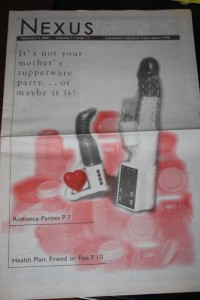 “We wanted to be able to explain that what we were doing was for a reason,” says Schreurs, “and that we thought it was valid.”
“We wanted to be able to explain that what we were doing was for a reason,” says Schreurs, “and that we thought it was valid.”
CHANGES AFOOT
When Nexus (known then as The Nexus) started out in 1990, it was a part of the Camosun College Student Society (CCSS); the two are now separated through an official separation agreement to ensure editorial autonomy at the newspaper and to avoid potential conflicts of interest that could arise otherwise.
“The CCSS organized a successful student referendum campaign asking the student body to support a newspaper,” says Schreurs about the beginnings of the paper. “The referendum was required in order to collect fees from every student at the time of registration. This was an important first step to establishing a student newspaper.”
CCSS student services coordinator Michael Glover says that student newspapers like Nexus are a chance for student reporters to get right what mainstream media gets wrong and to “really get out there and challenge some things.” Over the years since the separation agreement it has sometimes meant challenging the student society, but at the end of the day, each of the two parties understands where the other is coming from, and both have students at the forefront of their minds.
“There have been times when the student society and the Nexus have flare-ups,” says Glover, “but for the most part we have all just done the best we can together.”
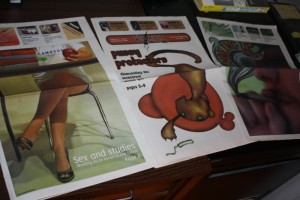 Although CCSS executive director Michel Turcotte admits that he hasn’t loved everything he’s read in Nexus over the years, he says he’s always appreciated that Camosun students have a vibrant newspaper and a chance to have their voices heard.
Although CCSS executive director Michel Turcotte admits that he hasn’t loved everything he’s read in Nexus over the years, he says he’s always appreciated that Camosun students have a vibrant newspaper and a chance to have their voices heard.
“My first memories of Nexus are of being lambasted in print by an extremely passionate student reporter,” says Turcotte. “I later took part in the process to make Nexus more independent from the CCSS and have been an avid reader for more years than I am willing to admit.”
As the paper moves into its next 25 years, it has a much larger reach than those involved in years past could even have imagined. Nexus runs breaking stories online that get read across Canada, and even beyond.
“The dawn of the internet has allowed an even wider reach,” says Turcotte, “with some of the articles helping to shape debates at other institutions and in the community.”
THE CAMOSUN PERSPECTIVE
An important point to note about the paper’s operations is that Nexus is the Camosun College student newspaper, not the Camosun College newspaper. The paper has no official ties to Camosun College, which means we can report on the college without bias.
Of course, this doesn’t always mean the college likes what they read, but the paper aims to represent the students of Camosun. If that means reporting on concerns they have with their institution, that’s what we’ll do.
“I would say I’ve been an avid reader of Nexus for a good 20 years,” says Camosun College vice president of communications, advancement, and planning Joan Yates. “I was an administrator, then I was a faculty member, then I was a dean, and now I’m at the VP level. Where Nexus has been particularly useful for me is just to get an idea of what’s engaging students, what are students talking about, what’s the conversation with students within our organization.”
Yates was often the one fielding questions from Nexus reporters over the years (current managing editor Greg Pratt remembers calling her for daily updates when ex-Camosun president Kathryn Laurin claimed she had her contract terminated for no reason), an experience which she appreciates despite it not always being a cheerful conversation.
“Certainly there have been occasions I would have liked Nexus reporters not asking me some hard questions,” says Yates with a chuckle. “But I always tried hard to answer them. Honestly, Nexus has made me work a few times, let me put it that way. But that is not a critique. I think that’s what you want in a free society, and I think that’s what you want in a college environment. You need people to be asking those questions, and I believe that very passionately. I think that Nexus has done a great job.”
The Camosun Chargers sports teams are located over at Interurban, so despite not having an office there, we try to keep our fingers on the pulse of that campus as well.
“The Camosun Chargers and Nexus have a long history together,” says Chargers athletics marketing officer Bonita Joe, who says that in some years the teams have received “amazing” coverage in the paper while other years have been “spotty at best.” “Nexus was there covering our story when the Chargers launched their first teams back in 1994.”
Yates says that the college looks to the paper to see what students care about, and that the paper can be a catalyst for change at Camosun.
“Yes, I think part of the process of change starts with awareness, and sometimes those changes are slow,” says Yates. “And while they may not always be huge, massive changes, they’re incremental changes and Nexus has had a strong and consistent influence in terms of that work.”
THE WRITERS
And here we come to the most important part of the history of the paper: you. Camosun students are the only people, apart from Nexus staff members, who can write for the paper. Over the years, we’ve seen an extremely large number of students go through its doors, and they’ve all helped shape the paper into what it is today.
Amanda Farrell-Low is currently an arts columnist for CBC Radio Victoria and a freelance journalist; she became a prominent Nexus writer during her time as a Camosun student (after her time at the paper she went on to be Monday’s arts editor). She says what lots of students have told Nexus staffers over the years: that her time at the paper was almost as important, if not as important, as the program she took at the college.
“It’s totally true because it really helped me hone my chops as a reporter,” she says. “Camosun’s [now-defunct] Applied Communications program was great for learning a lot of technical skills and project management, but in terms of writing and being a print journalist I would say Nexus was a huge part of why I ended up becoming a journalist.”
CTV News broadcaster Rachel Sovka wrote for the paper after living in southeast Asia for a year doing community development and teaching; when she came to Camosun as a student, she had a story to tell, and she wanted to tell it through the student newspaper.
“I knew I was a writer, so when I came back, I thought, I’ve got a story to tell, so I approached Greg and he loved it and we worked together to get it off the ground,” she says. “And the next thing you know there’s a picture of me riding an elephant on the front page of the paper.”
Sovka says that she wasn’t feeling very challenged by Camosun’s English classes, so the paper ignited a passion and purpose for her.
“I love Nexus, and it was totally instrumental in my career,” says Sovka. “I really have them to thank for so much. I work for CTV News in Halifax and I write the news for the number-one newscaster in the Maritimes. I wouldn’t be there without Nexus, for sure; it gave me confidence and experience to go for any job application and say, ‘I’ve done this, I’m ready to go, let’s do it.’”
Mike Devlin is an arts reporter at the Times Colonist and a former Nexus writer. He looks back on his days with the paper fondly; while he’s candid about the paper “not always getting it right” back in the days he was here, he has nothing but good things to say about his time here.
“I can’t say enough about how much I enjoyed it at Nexus and how much I enjoyed the Applied Communications program,” says Devlin. “That was single-handedly responsible for me getting a job at a daily newspaper as a music critic, which at the time was flat-out an impossibility. It’s kind of like this door opened for the one and only time it was going to open and I walked through.”
Sometimes the paper’s writers are also some of its biggest critics, as was the case with Daphne Shaed, who wrote Camosun College Student Society columns as the pride director and as the women’s director. Shaed gained a reputation for storming into the paper’s offices when an article saw print that she didn’t see eye to eye with.
“Nexus was a powerful experience for me,” says Shaed. “I really enjoyed writing at Nexus, and I had some really great and amazing conversations with Greg… I kind of miss stomping into the office.”
THE FUTURE
Being a student newspaper isn’t always easy: budgets are small, volunteers can vanish on deadline day, and the printing schedule marches forward regardless of stat holidays, photos that aren’t of high enough quality to print, or any other number of speed bumps that regularly pop up. But Nexus has soldiered on through the first quarter-century of existence and shows no signs of stopping now.
“Congratulations to Nexus,” says Camosun’s Yates. “I’m so pleased. I think the one concern I’ve ever had is once or twice we thought it wasn’t going to continue, when things have been a little tough when either there weren’t people to do the work or there was a little bit of financial issues over the years. It’s always been really great to see that things have prevailed and Nexus has carried on.”
And carry on it will, as we’re really only stopping here for a few pages this issue to look back on our history; apart from that, it’s full steam ahead. Student life never stops happening, so we can never stop, either. Through it all, the Camosun student writers will help guide the paper in the directions they want to see it go.
“It really is student-driven, and so if the students are energetic, lively, and fun, that reflects in the paper,” says former managing editor Schreurs. “There’s been a lot of really, really good teams over the years that have come through. It’s always been a student-driven paper and it really speaks to the student community. I think that’s important, and I think that it’s important that Camosun has its own voice that talks specifically about Camosun issues.”
Read about five of the most memorable stories in the paper’s history here.

